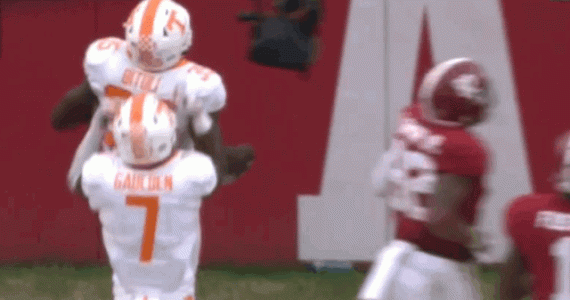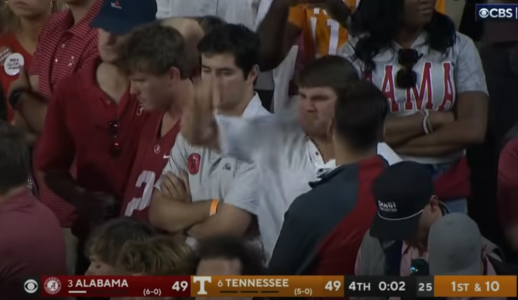I don't really like absolutes. Gosh forbid, Nico gets hurt, and 8 wins isn't a problem. All about the QB.Going forward this program should be at least a 9 win regular season team. Should have happened last year as well. The way they are recruiting/portaling crucial positions will have expectations where they need to be. 8 win season is a problem.
You are using an out of date browser. It may not display this or other websites correctly.
You should upgrade or use an alternative browser.
You should upgrade or use an alternative browser.
Recruiting Football Talk VIII
- Thread starter Freak
- Start date
- Status
- Not open for further replies.
Jackcrevol
All Day Long!
- Joined
- Jan 23, 2005
- Messages
- 75,524
- Likes
- 193,623
UTvol1fn
Rub A Dub Dub
- Joined
- Feb 5, 2008
- Messages
- 30,005
- Likes
- 9,608
drvenner
#LiftUpEllie
- Joined
- Jan 17, 2010
- Messages
- 44,721
- Likes
- 188,951
Man do I wish we played Mizzou this year.
Rent free baby. They literally made a t shirt after beating us rofl. Also, if I could offer a suggestion, why bother including MTSU, Memphis and Vandy on there? I would be kind of embarrassed to hang my hat on beating lesser teams, even as a joke. Just having the power T on there would’ve been much better.
I actually hate that we don’t play them just because id have loved to smack them on the mouth this year. It’s a travesty that in the first year of the playoffs they’re handed a schedule where we could have a path to 12-0 if we had the same. They just better hope that they don’t get exposed by the few good teams they actually play. TAMU vs Missouri is a game I will be watching for sure.
Weezer
VolNation Dalai Lama , VN Most Beloved Poster
- Joined
- Nov 13, 2009
- Messages
- 91,075
- Likes
- 271,857
Weezer
VolNation Dalai Lama , VN Most Beloved Poster
- Joined
- Nov 13, 2009
- Messages
- 91,075
- Likes
- 271,857
UTProf
Well-Known Member
- Joined
- Dec 24, 2010
- Messages
- 13,348
- Likes
- 32,991
August 6, 1945
US drops the first Atomic Bomb on Hiroshima, Japan.
After President Roosevelt died on April 12th, 1945, it became Harry Truman’s job to decide how to end the war. The thought of invading Japan gave Truman and his advisors pause. The war had shown that the Japanese were fighting for the Emperor who convinced them that it was better to die than surrender. Women and children had been taught how to kill with basic weapons. Japanese kamikaze pilots could turn planes into guided missiles. The cost of invasion, they knew, would be high.
Upon becoming president, Harry Truman learned of the Manhattan Project, a secret scientific effort to create an atomic bomb. After a successful test of the weapon, Truman issued the Potsdam Declaration demanding the unconditional surrender of the Japanese government, warning of “prompt and utter destruction.” Eleven days later, on August 6, 1945, having received no reply, an American bomber called the Enola Gay left the Tinian Island in route toward Japan. In the belly of the bomber was “Little Boy,” an atomic bomb. At 8:15 am Hiroshima time, “Little Boy” was dropped. The result was approximately 80,000 deaths in just the first few minutes. Thousands died later from radiation sickness.
View attachment 665174
My grandmother worked on Little Boy and her birthday was Aug 5th. None of them knew what they'd been working with until the bomb was dropped and telegrams from the War Dept. came in congratulating them on their work. Most of what they learned though came from the news releases that had been carefully crafted to run in every US newspaper at once. I never thought to ask her what it must've been like to be celebrating your birthday with all the other girls at Oak Ridge, only to find out you had a major hand in this. To be happy that the war might be over but then to hear that this bomb might've killed millions (in reality 80,000+ in Hiroshima but the numbers suggested at first were even bigger) must've been incredibly hard to process. They all knew what they were doing was important and for the war but they really had no idea just what they were working on until after the fact.
Glitch
You called down the thunder well now you've got it
- Joined
- Feb 3, 2013
- Messages
- 45,246
- Likes
- 222,898
Do you need a portable phone charging pack or something?I told y'all women would win Gold in Discuss. Poor refs, bet their ears are ringingView attachment 665025
Tennessee Golfer
I get my corn from a jar
- Joined
- Feb 9, 2008
- Messages
- 13,665
- Likes
- 53,060
PlanetVolunteer
Well-Known Member
- Joined
- Apr 4, 2020
- Messages
- 12,800
- Likes
- 41,699
They would have zero chance of beating us in Neyland. Can we trade our road game with UGA for it?Rent free baby. They literally made a t shirt after beating us rofl. Also, if I could offer a suggestion, why bother including MTSU, Memphis and Vandy on there? I would be kind of embarrassed to hang my hat on beating lesser teams, even as a joke. Just having the power T on there would’ve been much better.
I actually hate that we don’t play them just because id have loved to smack them on the mouth this year. It’s a travesty that in the first year of the playoffs they’re handed a schedule where we could have a path to 12-0 if we had the same. They just better hope that they don’t get exposed by the few good teams they actually play. TAMU vs Missouri is a game I will be watching for sure.
Weezer
VolNation Dalai Lama , VN Most Beloved Poster
- Joined
- Nov 13, 2009
- Messages
- 91,075
- Likes
- 271,857
VolMike16
Well-Known Member
- Joined
- Dec 7, 2012
- Messages
- 1,621
- Likes
- 2,758
Rishvol
Well-Known Member -StoVol
- Joined
- Jan 10, 2016
- Messages
- 26,765
- Likes
- 62,926
Enki_Amenra
Wanna Bet?
- Joined
- Dec 22, 2012
- Messages
- 49,298
- Likes
- 249,680
Glitch
You called down the thunder well now you've got it
- Joined
- Feb 3, 2013
- Messages
- 45,246
- Likes
- 222,898
Rishvol
Well-Known Member -StoVol
- Joined
- Jan 10, 2016
- Messages
- 26,765
- Likes
- 62,926
Enki_Amenra
Wanna Bet?
- Joined
- Dec 22, 2012
- Messages
- 49,298
- Likes
- 249,680
Orange_Crush
Resident windbag genius
- Joined
- Dec 1, 2004
- Messages
- 42,717
- Likes
- 88,089
Orangeburst
Jesus-I am the light of the world. (John 8:12)
- Joined
- Jun 19, 2008
- Messages
- 53,145
- Likes
- 127,739
kemotoe
I’m probably being sarcastic.
- Joined
- Feb 3, 2016
- Messages
- 1,858
- Likes
- 5,868
volbeast33
You can count on Carlos!
- Joined
- Mar 21, 2009
- Messages
- 35,539
- Likes
- 108,581
- Status
- Not open for further replies.








